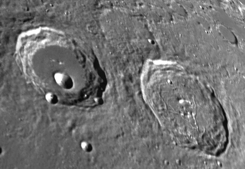 The week of July 30-August 5 takes us from Day 17 to Day 23. This week we will highlight the craters Hercules and Atlas, viewable around 2:00 AM EDT on Tuesday.
The week of July 30-August 5 takes us from Day 17 to Day 23. This week we will highlight the craters Hercules and Atlas, viewable around 2:00 AM EDT on Tuesday.
Hercules and Atlas: [NE/E13-14] Just east of the charmingly named Lacus Mortis (the “Lake of Death”) are two splendid craters, Hercules and Atlas. They have been described variously as “noble, magnificent, spectacular, scarcely surpassed.” Although in Greek mythology Hercules and Atlas were contemporaries, the craters named after them appeared at widely different times. You should be able to tell at a glance which crater is older. (Make a decision before looking at the footnote.)1 There is a large simple crater on the floor of Hercules. Can you tell if it is bowl-shaped or does it have a flat floor?2
 Atlas has central peaks, rilles, a hummocky floor, and two small dark haloes known as lunar pyroclastic deposits. It is also one of the Moon’s many examples of a floor-fractured crater (FFC).
Atlas has central peaks, rilles, a hummocky floor, and two small dark haloes known as lunar pyroclastic deposits. It is also one of the Moon’s many examples of a floor-fractured crater (FFC).
Hercules has multiple terraces, and if you look very closely at it under the right lighting you will notice two small bumps that are reminiscent of the crater Cassini, which you will encounter on Day 7 [E10]. These tiny bumps, located just north of the large internal crater Hercules G, are actually the tops of enormous mountains that have been almost entirely inundated by abundant lava flows. Hercules is also the site of reported lunar transient phenomena (LTP’s).
Did you notice that both Atlas and Hercules have blankets of surrounding ejecta, known as a glacis? The historical meaning of glacis is an artificial slope extending down from a fortification to allow the defenders to have a clear shot at the enemy when they are close. The slope of a lunar glacis will typically be a gentle 5-15°.
OF ADDITIONAL INTEREST:
There is hugely exciting news about Mars: a 12-mile-wide lake of liquid water has recently been discovered by radar imaging on Mars! It is hidden one mile below the southern ice cap. Such a discovery enormously increases the possibilities of finding extraterrestrial life, although it will be decades before we will actually be able to drill beneath the Martian surface to get samples for analysis.
1 Because the walls are more deteriorated and its interior contains more small craters, Hercules is the older crater.
2 The floors of bowl-shaped simple craters are round and their shadows will be curved. If enough debris has fallen from the crater walls to create flat floors, the shadows will be truncated; i.e., the apex will be squared off.
======================
It is highly recommended that you get a copy of Sky and Telescope’s Field Map of the Moon, the very finest Moon map available for use at the telescope. It is available for $10.95 at www.skyandtelescope.com and on Amazon. All features mentioned in this blog will be keyed to the grid on the Field Map and will look like this: Plato: [NW/D9]
Credits:
Courtesy of Gray Photography of Corpus Christi, Texas
Lunar photos: NASA / USGS / BMDO / LROC / ASU / DLR / LOLA / Moon Globe. Used by permission
- Rupes Cauchy: A Best Known Fault on the Moon - July 22, 2024
- Moon Crater Schickard – Crater Floor has Stripes - July 15, 2024
- Moon Craters Langrenus and Vandelinus - July 8, 2024